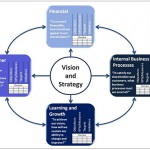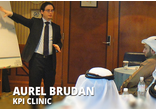Strategy Communication and Risk Management as enablers of organizational success – Insights from Dr. Robert Kaplan
A recent interview conducted by Bruno Aziza, Director – Worldwide Strategy Lead – Business Intelligence at Microsoft with Dr. Robert Kaplan “Baker Foundation Professor” at Harvard Business School, co-creator of the Balanced Scorecard concept, reveals several interesting insights on the key enablers of strategy execution and organizational success.
Strategy should be understood and executed by all the employees
According with Dr. Kaplan the role of the senior management teams is to plan, formulate and manage the strategy, while its execution should be the responsibility of all employees throughout an organization. Dr. Kaplan acknowledges also that one of the main reasons for which strategies fail is because 90 to 95% of employees don’t know what the strategy of the organization is and in consequence they can’t understand and implement it. According to him, one of the roles of the Balanced Scorecard system is to overcome this problem by translating the strategy into a clear visual representation of the strategic objectives and their related performance indicators through the Strategy Map and Balanced Scorecard.
Strategy communication is key for organizational success
Formulating and translating the strategy into easily understandable visual tools such as the Strategy Map or the Balanced Scorecard is not enough when it comes to actually implement the strategy. Creating awareness about the strategy and main strategic directions throughout the organizations is one of the most critical aspects that need to be overseen when implementing a new strategy no matter of the system used to translate it with. Therefore communication is vital in this process and the strategy needs to be communicated to employees if necessary “seven times in seven ways”.
Volkswagen Brazil – a leading example in strategy communication
One of the leading examples of how a strategy can be effectively communicated to employees enabling its successful implementation is according with Dr. Kaplan the case of Volkswagen Brazil. The company decided to implement a new strategy focused on innovation and growth.
In order to effectively communicate and implement their new strategy the company took several actions:
1. They translated the strategy into a simple, very easily to understand Strategy Map, representing a core set of interlinked strategic objectives;
2. They represented the financial and customer perspectives of the Strategy Map in the national colors of Brazil in order to outline the idea of performance and success as a reminder of the World Cup successes;
3. They put a Strategy Map on the walls of every room of the company’s four manufacturing plants, so everyone can see it;
4. They facilitated training sessions, they introduce games and they even created a robot called Giga in order to engage employees and communicate the strategy.
As a result of these efforts, some 16,000 of new innovation ideas were captured from the 22.000 employees, the employee morale and engagement boosted exponentially and in two years time the company grew its revenue from $6.7 billion to $9 billion recapturing the number one spot in Brazil in terms of market share.
Risk Management – a critical function for organizations in the current economic environment
In the context of the global financial crisis, as well as other exceptional events such as the environmental disaster caused by BP’s Deepwater Horizon rig explosion and subsequent oil spill, Dr. Kaplan considers that risk is one of the most unexplored areas in most of the organizations and one of the main causes of companies’ failure.
Subsequently he recognizes that risk is one of the most difficult measurement problems encountered, as it is hard to capture. Therefore Dr. Kaplan catalogs Key Results Indicators (KRIs) to be the really leading indicators of future performance. While talking about the importance of anticipating and mitigating risks in the context of strategy management, the risk management system is considered by him complementary but different from the strategy execution system.
For more insights on the topics briefly outlined above, watch below the video interview with Dr. Robert Kaplan:

Tags: Balanced Scorecard, KPI, KRI, Performance Management, Risk Management, Robert Kaplan, Strategy Map





